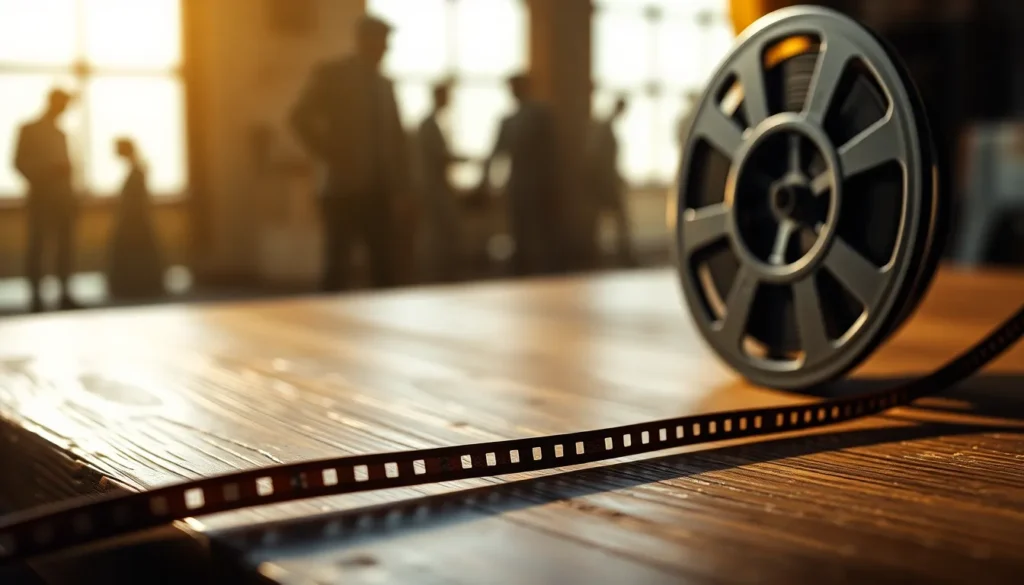Table of Contents
ToggleMovies are more than just flashy visuals and catchy soundtracks; they’re a treasure trove of hidden meanings waiting to be uncovered. Ever watch a film and think, “Wait, what did that really mean?” That’s subtext at play, the sneaky little devil that adds depth to storytelling. It’s like the secret sauce in your favorite dish—without it, everything feels a bit bland.
Understanding Subtext in Movies
Subtext adds depth to films, allowing viewers to extract richer meanings. It shapes characters and narratives beyond surface-level plots.
Definition of Subtext
Subtext refers to underlying themes and meanings in dialogue and visuals. Filmmakers often use it to convey emotions or societal issues without overtly stating them. For instance, a character’s subtle glance might signify distrust even if no words are spoken. Viewers can infer messages based on context clues and character interactions. This approach encourages audience engagement by prompting deeper analysis of scenes. Understanding subtext enhances the viewing experience, transforming how individuals perceive and connect with the story.
Importance of Subtext in Storytelling
Subtext plays a critical role in storytelling by enriching character development and plot intricacies. Meaning often lies in what’s unsaid rather than explicit dialogue. Effective use of subtext fosters emotional resonance, allowing the audience to relate to characters on profound levels. Films like “The Godfather” exemplify how nuanced details add layers to the narrative. This technique invites viewers to explore themes like power, loyalty, and betrayal. Engaging with subtext fosters a connection between the audience and the film, making the experience more immersive and thought-provoking.
Examples of Subtext in Classic Films

Classic films often use subtext to convey deeper meanings. Key scenes and recurring themes explore societal issues and human emotions in subtle ways.
Analyzing Key Scenes
Witness the iconic scene in The Godfather when Michael Corleone visits the restaurant. The dialogue appears straightforward, yet the tension reveals underlying motivations about loyalty and power. Another example comes from Casablanca, where Rick’s comments about “As Time Goes By” mask his feelings for Ilsa. Subtext connects characters’ true desires with their actions, enhancing the viewer’s understanding of relationships.
Themes and Motifs
Recurring motifs enhance visual storytelling. In Psycho, the shower scene represents vulnerability juxtaposed with deceit. Themes of isolation and fear permeate the film, reflecting broader societal anxieties. In Gone with the Wind, the struggles of Scarlett O’Hara signify resilience amid adversity. The use of these themes contributes to richer narratives, inviting viewers to engage with layers of meaning beyond the surface plot.
The Role of Subtext in Character Development
Subtext significantly influences character development in films. It adds complexity by revealing internal struggles and motivations through subtle cues rather than direct statements.
How Subtext Shapes Characters
Subtext builds characters with depth. In “The Godfather,” Michael Corleone’s evolution from reluctant participant to ruthless leader occurs amidst layers of unsaid loyalty and power. Characters often express true feelings indirectly, allowing audiences to glean their motivations. The dialogue in “Casablanca” showcases Rick Blaine’s hidden emotions, as his words hint at deep emotional wounds linked to love and loss. Subtle choices in actions and expressions further enhance the portrayal of characters, enriching their arcs and making them relatable. The complexity of their journeys elicits empathy, transforming audiences’ engagement with the narrative.
Subtextual Relationships in Film
Subtext creates intricate relationships between characters. In “Psycho,” the tension between Norman Bates and Marion Crane unfolds through hidden fears and desires, showcasing the undercurrents of their connection. Dialogue exchanges often suggest more than they verbalize, hinting at underlying conflicts and emotional bonds. The relationships in “Gone with the Wind” illustrate a blend of love, betrayal, and survival, often conveyed through unspoken words and actions. Filmmakers use subtext to portray relationships as multifaceted, making interactions resonate with complexities. Audiences appreciate the depth in these connections, enhancing their understanding of characters and drawing them into the story.
Techniques for Identifying Subtext
Identifying subtext requires an attentive approach, focusing on various elements within a film. Visual cues and dialogue often hold key insights into deeper meanings.
Visual Cues and Symbolism
Visual elements reveal layers of meaning that enrich the storytelling experience. Symbols often take the form of colors, objects, or settings that represent broader themes. For example, a red object might symbolize passion or danger, while shadows can evoke feelings of isolation. Noticing recurring motifs, such as a character’s movements or specific angles, can also hint at their internal struggles or motivations. Subtle changes in lighting may indicate emotional shifts, guiding viewers to interpret scenes beyond their surface appearance. Recognizing these visual cues enhances understanding and appreciation of the film’s message, emphasizing the artistry of storytelling.
Dialogue and Subtextual Meaning
Dialogue frequently contains more than explicit statements. Subtext often hides in the pauses, hesitations, or contradictions found within conversations. Characters may say one thing while implying another, creating a rich tapestry of meanings. For instance, an offhand comment might reflect deeper insecurities or desires. Listening for changes in tone or emphasis can reveal emotional subtexts that drive character interactions. Additionally, repeated phrases or questions might highlight unresolved conflicts or tensions. Analyzing these dialogues allows viewers to uncover relationships and motivations that shape the narrative, adding depth to their viewing experience.
Subtext serves as a powerful tool in filmmaking that transforms ordinary narratives into extraordinary experiences. By weaving deeper meanings into dialogue and visuals, filmmakers invite audiences to explore complex themes and emotions. This subtlety not only enhances character development but also fosters a more profound connection between viewers and the story.
As audiences become more attuned to these layers, their appreciation for the artistry of film deepens. Understanding subtext enriches the viewing experience, encouraging viewers to engage critically with what lies beneath the surface. Ultimately, recognizing the hidden elements in films opens up a world of interpretation that can resonate long after the credits roll.







